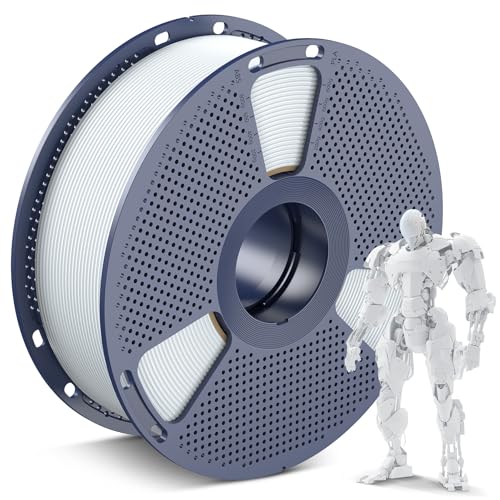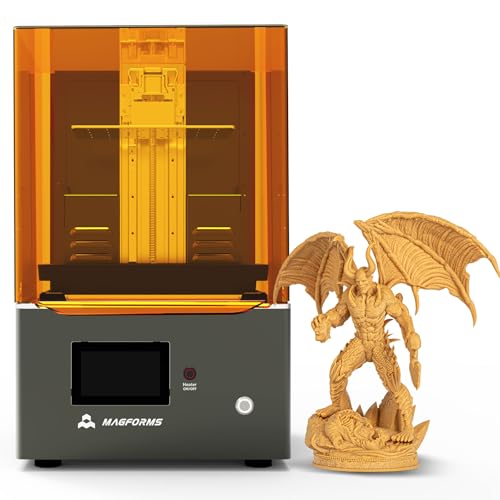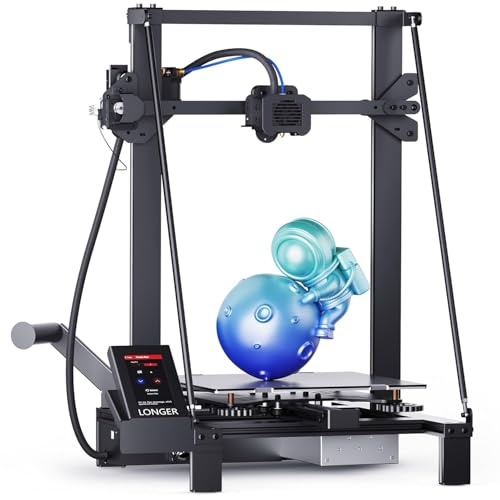As you explore the evolving landscape of industrial ceramic 3D printers, you’ll notice a shift towards models that emphasize precision and performance. With advancements like Liquid Deposition Molding and enhanced feeding systems, these printers are set to transform both artistic and manufacturing processes. Among the top contenders, you’ll find options that stand out for their reliability and user-friendly designs. Curious about which printers made the cut for 2025? Let’s take a closer look.
QIDI MAX3 High-Speed 3D Printer
The QIDI MAX3 High-Speed 3D Printer stands out as an excellent choice for both professionals and beginners looking to tackle intricate designs or small-scale prototypes. With a remarkable printing speed of 600mm/s and a spacious build size of 325mm x 325mm x 315mm, it accommodates various projects. Its ultra-stable all-metal frame and low-maintenance components guarantee reliability, while the direct drive extruder supports a wide range of materials, including specialty options. You’ll appreciate the responsive customer support and user-friendly software, making it perfect for artistic creations or functional items. The MAX3 truly delivers exceptional performance in the world of 3D printing.
Best For: The QIDI MAX3 High-Speed 3D Printer is best for both professionals and beginners seeking to produce intricate designs and small-scale prototypes efficiently.
Pros:
- High printing speed of 600mm/s allows for rapid project completion.
- Compatible with a wide range of materials, including specialty filaments like carbon fiber and nylon.
- User-friendly software and responsive customer support enhance the overall user experience.
Cons:
- Limited maximum print size may not accommodate larger projects.
- Fully assembled design may not appeal to users who prefer a DIY assembly experience.
- Some users may require time to learn the open-source Klipper firmware for optimal performance.
SUNLU PLA 3D Printer Filament 1.75mm (1kg Spool)
For those seeking a reliable and versatile option in 3D printing, the SUNLU PLA 3D Printer Filament 1.75mm (1kg Spool) stands out with its exceptional layer adhesion and clog-free design. This filament, compatible with 99% of FDM printers, guarantees smooth extrusion and consistent quality, making it perfect for both beginners and experts. Its neat winding eliminates tangles, while the recommended nozzle temperature of 200-230°C provides ideal results. Rated 4.3 stars by users, it’s praised for its performance and value, costing around $10 per spool. Choose SUNLU for intricate prints and reliable results every time.
Best For: Those looking for a reliable and high-quality 3D printing filament that works well for both intricate designs and everyday prints.
Pros:
- Excellent layer adhesion and smooth extrusion for high-quality prints.
- Compatible with 99% of FDM 3D printers, making it versatile for various setups.
- Rated 4.3 stars by users, indicating consistent performance and value at around $10 per spool.
Cons:
- Some users may find it difficult to locate filament ends on the spools.
- Suggested improvements include using lighter tape for better visibility of filament ends.
- May require careful temperature adjustments to achieve optimal printing results.
ANYCUBIC Photon Mono 4 Resin 3D Printer
Looking for a reliable resin printer that offers exceptional print quality without breaking the bank? The ANYCUBIC Photon Mono 4 is your answer. With a 7-inch 10K Mono LCD screen and a printing speed of 70mm/h, it delivers sharp details with minimal layer lines. Its print volume of 6.04 x 3.42 x 6.49 inches is perfect for various projects. Users praise its ease of setup and user-friendly features, although some mention minor issues with the touchscreen and software. Overall, it’s an ideal choice for beginners wanting high-quality prints at an affordable price.
Best For: Beginners and hobbyists looking for an affordable resin printer that delivers high-quality prints with ease of use.
Pros:
- High resolution of 9024×5120 provides sharp details and smooth surfaces.
- User-friendly setup and features, including a 4-point leveling method and power recovery for resumed printing.
- Fast printing speed of 70mm/h with a decent print volume for various projects.
Cons:
- Some users report issues with the lightweight plastic build and low-quality touchscreen.
- Potential durability concerns regarding the resin vat and compatibility with other models.
- Occasional software bugs in the slicer (Photon Workshop) and USB recognition problems.
ELEGOO Neptune 3 Pro 3D Printer
Offering a generous build volume of 225x225x280 mm, the ELEGOO Neptune 3 Pro 3D Printer is an excellent choice for hobbyists and professionals alike who need a reliable machine for daily projects. It features a pre-assembled design for quick setup, and you’ll be ready to print in minutes. With dual-gear direct drive extruders and silent stepper motors, you’ll enjoy smooth, accurate prints at low noise levels. The auto bed leveling, filament runout sensor, and power-loss resume function enhance user experience. Its durable components guarantee stability and precision, making it a dependable addition to your 3D printing toolkit.
Best For: The ELEGOO Neptune 3 Pro 3D Printer is best for both hobbyists and professionals seeking a reliable and user-friendly printing solution for a variety of projects.
Pros:
- Pre-assembled design allows for quick setup, making it user-friendly for beginners.
- Dual-gear direct drive extruder ensures consistent filament feeding, accommodating various materials like PLA, TPU, and ABS.
- Advanced features like auto bed leveling and power-loss resume enhance reliability during complex prints.
Cons:
- Build volume may be limiting for users needing to print larger models.
- Noise levels at 47dB, while low, may still be noticeable in quiet environments.
- Durability of components could vary depending on usage intensity and maintenance.
X1 3D Printer, 8K Resin Industrial Grade 3D Printer
The ApexMaker X1 3D Printer stands out as an exceptional choice for professionals and businesses seeking high-quality industrial-grade printing solutions. With its impressive 8K resolution of 7680 x 4320 on a 16-inch UV curable LCD, you’ll achieve unmatched detail and accuracy. Its dimensions offer a generous printing volume of 21.6 x 17.3 x 33.94 inches, making it versatile for various projects. Plus, it’s compatible with popular slicing software, ensuring ease of use for everyone. You’ll also appreciate the thorough after-sales support and the option to provide price feedback, enhancing your overall experience with this outstanding printer.
Best For: Professionals and businesses seeking high-quality, industrial-grade 3D printing solutions with exceptional detail and accuracy.
Pros:
- High-resolution 8K printing for unmatched detail and precision.
- Generous printing volume suitable for a variety of projects.
- Compatible with popular slicing software, making it user-friendly for all skill levels.
Cons:
- Industrial-grade features may be more than what casual users need.
- Larger dimensions may require more space for setup and operation.
- Price feedback mechanism may not guarantee immediate price adjustments.
MateForm Air 4 Resin 3D Printer
For those seeking unparalleled precision in industrial 3D printing, the MateForm Air 4 Resin 3D Printer stands out with its impressive 14.85μm resolution. This ultra-high precision LCD printer features an industrial-grade MSLA design and a generous build volume of 8.98 x 5.05 x 9.84 inches. Its carbon steel shell and industrial components guarantee stability and durability, minimizing wobbling for high success rates. With a self-developed light source, it achieves uniform energy distribution, enhancing print accuracy. Plus, the built-in heater maintains ideal temperatures, and the activated carbon filter keeps your workspace clean. Enjoy reliable support with an all-encompassing warranty.
Best For: Professionals and businesses seeking high-precision 3D printing solutions for detailed models and prototypes.
Pros:
- Ultra-high precision with a resolution of 14.85μm for exceptional detail in prints.
- Durable industrial-grade construction ensures stability and longevity during operation.
- Advanced features such as a self-developed light source and built-in heater enhance print accuracy and maintain optimal printing conditions.
Cons:
- Weighty design at 25kg may require a sturdy setup space.
- Limited warranty coverage for consumables and LCD screen may lead to additional costs over time.
- Requires compatible resins, which may limit options for users wanting to experiment with different materials.
Longer LK5 Pro 3 3D Printer
Designed with both beginners and enthusiasts in mind, the Longer LK5 Pro 3 3D Printer stands out for its impressive large printing size and user-friendly setup. With a generous build volume of 11.8×11.8×15.7 inches, you can tackle various projects, from small figurines to larger models. Its FDM technology guarantees high precision and fast printing speeds, while the fully open-source motherboard allows for easy upgrades. You’ll appreciate the mostly pre-assembled design, making setup feel like a breeze. Plus, an active support community offers guidance and resources, encouraging you to engage in creative projects with confidence.
Best For: The Longer LK5 Pro 3D Printer is best for both beginners looking for an easy setup and enthusiasts seeking high-quality prints with a large build volume.
Pros:
- User-friendly design: Easy plug-and-play setup with clear instructions and pre-assembled components.
- High print quality: Delivers precise and accurate prints at fast speeds, suitable for various project sizes.
- Active community support: Access to numerous tutorials and resources, enhancing the user experience and confidence.
Cons:
- Initial intimidation: The size and features may seem overwhelming for complete beginners at first glance.
- Magnetic bed suggestion: A magnetic bed may be preferred over a glass bed, which could require additional investment.
- Limited advanced features: While great for beginners, more experienced users might find the capabilities somewhat basic compared to higher-end models.
Longer LK5 Pro 3D Printer
With its impressive printing size of 11.8 x 11.8 x 15.7 inches, the Longer LK5 Pro 3D Printer stands out as an excellent choice for both hobbyists and professionals looking to tackle ambitious projects. It boasts a stable triangular structure that minimizes resonance errors, ensuring high precision at a remarkable speed of 180 mm/s. You’ll appreciate its compatibility with various materials, opening up endless creative possibilities. The printer also features filament depletion detection and an ultra-quiet driver for smooth operation. Plus, with 90% pre-assembly, you’ll get started quickly, and 24-hour customer support is ready to assist whenever you need it.
Best For: The Longer LK5 Pro 3D Printer is best for hobbyists and professionals seeking a reliable and spacious 3D printing solution for ambitious projects.
Pros:
- High precision printing with a speed of 180 mm/s, suitable for detailed designs.
- Stable triangular structure and upgraded features ensure durability and reduced errors.
- User-friendly with 90% pre-assembly and 24-hour customer support for assistance.
Cons:
- Requires some technical knowledge for optimal setup and operation despite pre-assembly.
- Limited to the maximum build size, which may not accommodate very large projects.
- May need frequent maintenance or adjustments for consistent performance over time.
Official Creality Ender 3 3D Printer
The Official Creality Ender 3 3D Printer stands out as a top choice for hobbyists and small businesses looking to explore the world of 3D printing without breaking the bank. With a build volume of 8.66 x 8.66 x 9.84 inches, it’s fully open source and easy to customize. The printer features a resume printing function to recover from outages and advanced extruder technology for smooth operation. Assembly takes about two hours, and user support is plentiful online. Many users recommend PLA filament for its low fumes and eco-friendliness, making this printer a reliable entry point into 3D printing.
Best For: Hobbyists and small businesses looking for an affordable and customizable entry into 3D printing.
Pros:
- Affordable: Offers great value for those new to 3D printing.
- Community Support: Extensive online resources and forums provide assistance and tips.
- User-Friendly Features: Resume printing function and advanced extruder technology enhance usability.
Cons:
- Assembly Required: Initial setup can be time-consuming and overwhelming for some users.
- Learning Curve: Users may face challenges with bed leveling and printing settings.
- Filament Quality Variability: Quality of filament can vary, requiring careful selection for optimal results.
TRONXY Moore 2 Pro Ceramic Clay 3D Printer
For artists and manufacturers looking to explore the world of ceramic 3D printing, the TRONXY Moore 2 Pro stands out as an exceptional choice. With a build size of 250mm x 250mm x 260mm, it accommodates various materials like clay and ceramics slurry. Its liquid deposition molding technology offers a maximum printing speed of 40mm/s, allowing for rapid prototyping. The newly designed screw feeding device enhances stability, while the dual-axis metal guide rail ensures smooth operation. Plus, you won’t need an air compressor, making it user-friendly for beginners keen to create stunning ceramic pieces.
Best For: Artists and manufacturers looking to experiment with ceramic 3D printing and create intricate designs.
Pros:
- User-friendly design eliminates the need for an air compressor, making it accessible for beginners.
- High-speed printing capability of 40mm/s allows for rapid prototyping and efficient workflow.
- Robust construction with dual-axis metal guide rails ensures smooth and stable operation during printing.
Cons:
- Limited build size of 250mm x 250mm x 260mm may not accommodate larger projects.
- Adjustable layer thickness range may require fine-tuning for optimal results, which could be challenging for some users.
- Specialized materials such as ceramics may not be suitable for all types of 3D printing applications.
Factors to Consider When Choosing Industrial Ceramic 3D Printers
When choosing an industrial ceramic 3D printer, you’ll want to take into account several key factors. Think about the build volume and size, as well as how compatible the printer is with different materials. Additionally, evaluate the printing technology, speed, user-friendly features, and precision levels to guarantee you get the best fit for your needs.
Build Volume and Size
Choosing the right build volume is essential for maximizing the potential of your industrial ceramic 3D printer. The build volume determines the maximum size of objects you can create, with options ranging from about 250mm x 250mm x 260mm to larger formats. A bigger build size allows for more complex designs, enabling you to produce significant pieces without assembling multiple parts. Additionally, larger dimensions can enhance workflow efficiency, reducing the frequency of print jobs and saving time during production. However, consider the printer’s footprint, as larger machines may need more space in your workshop, impacting layout and accessibility. Verify the build size aligns with your intended applications, especially if specific dimensions are required for your ceramic components.
Material Compatibility and Versatility
Material compatibility and versatility are vital factors in selecting an industrial ceramic 3D printer, as they directly influence your workflow and the range of projects you can tackle. You’ll want a printer that supports various materials like clay, ceramics slurry, and red porcelain to meet diverse prototyping and production needs. It’s important that the printer can manage different viscosities and flow characteristics to guarantee consistent print quality. Look for adjustable layer thickness, ranging from 0.3mm to 3mm, to customize detail and strength. A reliable feeding system, such as a screw feeding device, enhances performance by ensuring smooth material flow. Compatibility with both traditional and advanced ceramic materials allows you to explore innovative designs and functional prototypes effectively.
Printing Technology and Speed
Having the right materials is just the beginning; the printing technology and speed of an industrial ceramic 3D printer play a significant role in determining your project’s success. Most industrial ceramic printers utilize Liquid Deposition Molding technology, which allows for the precise extrusion of ceramic materials, enabling intricate designs. You’ll notice that printing speeds can vary, with some models reaching up to 40mm/s, ideal for rapid prototyping. Layer thickness also matters, typically adjustable between 0.3mm and 3mm, giving you control over detail and surface finish. Additionally, consider the feeding system; electric putters often outperform air compressors, enhancing stability and quality. Ultimately, speed and technology directly impact your print’s efficiency and precision, so choose wisely based on your specific needs.
User-Friendly Features and Setup
When exploring industrial ceramic 3D printers, user-friendly features and a straightforward setup can make a significant difference, especially for those new to the technology. Look for printers that come pre-assembled or require minimal assembly to save time and reduce complexity. Features like auto bed leveling simplify initial setup, ensuring a solid first layer. It’s also beneficial to choose models with clear instructions and support resources, such as online tutorials or community forums, for guidance during setup. Intuitive interfaces or touchscreen controls can make maneuvering settings easier. Finally, evaluate the availability of responsive customer service or technical support to help you troubleshoot any issues that may arise during setup and printing phases.
Precision and Accuracy Levels
User-friendly features set the stage for successful printing, but precision and accuracy levels are what truly define the quality of your industrial ceramic 3D prints. When choosing a printer, consider the layer thickness, which can range from 0.3mm to 3mm; this directly impacts the detail in your final product. Look for printers with high resolutions, like 14.85μm, to achieve exceptional detail. Stability during printing is vital, as any wobbling can lead to inaccuracies; consequently, opt for models with dual-axis metal guide rails. Consistent material flow is equally important—advanced feeding systems help minimize defects and enhance print quality. Finally, the design technology, such as liquid deposition molding, greatly influences both precision and adherence to your intended design.
Structural Stability and Durability
Structural stability and durability are vital factors that influence the overall performance of industrial ceramic 3D printers. A printer’s robust construction, featuring dual-axis metal guide rails and durable components, minimizes resonance errors and enhances precision. When you choose a model with industrial-grade materials like carbon steel shells, you’re investing in reduced wobbling and vibrations, which directly affects print quality. Effective weight distribution and support systems are essential, especially for tall or heavy prints, guaranteeing consistent performance. Advanced features such as adjustable feeding systems and stable motion mechanisms further contribute to reliable prints, minimizing defects or failures. By prioritizing these elements, you’ll make certain your printer delivers high-quality results over its lifespan.









